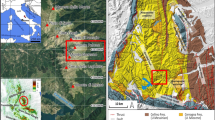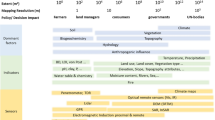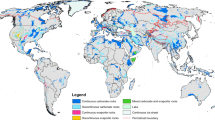Abstract
Floating and grounded peat plateaus were studied in fens in the Yukon Territory (Canada). The peat deposit may be over 4 m thick and consists of a lower bed of aquatic peat overlain by humic fen peat, mesic fen peat and woody peat. Permafrost in the grounded peat plateaus is older than the 1200 year old White River Ash, whereas permafrost in the floating peat plateau is younger.
Peat accumulation rates since 1200 years B.P. were greater in the fens (85–100 cm) than on the surface of the peat plateaus (25–55 cm). Where the peat plateau is free-floating, it will persist until the climate changes, causing the icy core to thaw. Where the peat plateau is frozen to the mineral substrate, it slowly drowns since the fen peat accumulates faster than the woody peat. This drowning results in degradation of the landform independently of the climate. Only degradation of floating peat plateaus can be used to identify climatic changes.
Similar content being viewed by others
References
AES, 1982. Canadian Climatic Normals: Temperature and Precipitation, 1951–1980. The North-Y.T. & N.W.T.Environment Canada, Atmospheric Environment Service, Ottawa, 55 pp.
AES, monthly. Monthly Record. Environment Canada, Atmospheric Environment Service, Toronto.
Antevs, E., 1948. The Great Basin, with emphasis on glacial and postglacial times. III. Climatic changes and pre-white man. Univ. of Utah Bull. 38: 168–191.
Allard, M. & M.-K. Seguin, 1987. Le pergélisol au Québec Nordique: bilan et perspectives. Géogr. Phys. Quat. 41: 141–152.
Blusson, S. L., 1966. Geology of the Frances Lake, Yukon Territory and District of Mackenzie 105H. Geol. Sur. Can., Map 6.
Brown, R. J. E., 1970. Occurrence of permafrost in Canadian peatlands. Proceedings, 3rd Int. Peat Congress, Quebec. National Research Council, Ottawa, Canada: 174–181.
Brown, R. J. E. & W. O. Kupsch, 1974. Permafrost Terminology. National Research Council Canada, Associate Committee on Geotechnical Research, Ottawa. Technical Memorandum #111, 62 p.
Capps, S. R., 1915. An ancient volcanic eruption in the upper Yukon basin. U.S. Geol. Survey Professional Paper #95: 59–64.
Dever, L. C., C. Hillaire-Marcel & J. Fontes, Jr., 1984. Composition isotopique, géochimie et genèse de la glace en lentilles (palsen) dans les tourbières au Nouveau Québec (Canada). J. Hydrology 71: 107–130.
Dyke, A. S., 1981. Surficial geology of the Frances Lake area, 105H, edition 4. Geol. Survey of Canada Open File Report #895.
French, H. M., 1976. The periglacial environment. Longman Group, London.
Fries, T. & E. Bergström, 1910. Några iakttagelser övfrer palsar od deras förekomst i nordligaste Sverige. Geol. Fören. Förhandl. Bd. 32, vol. 1, Stockholm.
Gahé, É., M. Allard & M.-K. Seguin., 1987. Géomorphologie et géophysique de plateaux palsiques à Kangigslualujjuaq, Québec nordique. Géogr. Phys. Quat. 41: 47–64.
Hamelin, L. E. & A. Cailleux, 1969. Les palses dans le bassin de la Grande Rivière de la Baleine. Revue Géographie de Montréal 23: 329–337.
Harris, S. A., 1981. Distribution of zonal permafrost landforms with freezing and thawing indices. Erdkunde 35: 81–90.
Harris, S. A., H. M. French, J. A. Heginbottom, G. H. Johnston, B. Ladanyi, D. C. Sego & R. O. van Everdingen, 1988. Glossary of permafrost and related ground-ice terms. Permafrost Subcommittee, Associate Committee on Geotechnical Research, National Research Council of Canada. Technical Memorandum #142, 156 pp.
Harris, S. A., 1988. Observations on the redistribution of moisture in the active layer and permafrost. Proc., 5th Int. Permafrost Conference, Trondheim, Norway, Tapir Press, Trondheim: 1: 364–369.
Harris, S. A., 1993. Palsa-like mounds developed in a mineral substrate, Fox Lake, Yukon Territory. Proc., 6th Int. Conference on Permafrost, Beijing: 1: 238–243.
Harris, S. A. & D. Nyrose, 1992. Palsa formation in floating peat and related vegetation cover as illustrated by a fen bog in the MacMillan Pass, Yukon Territory, Canada. Geografiska Annaler 74A: 349–362.
Harris, S. A., I. H. Schmidt & H. R. Krouse, 1992. Hydrogen and oxygen isotopes and the origin of ice in peat plateaus. Permafrost & Periglacial Processes 3: 19–27.
Harris, S. A., N. M. Waters & H. R. Krouse, 1993. Hydrogen and oxygen isotopes and the origin of the ice in peat plateaus: Reply. Permafrost & Periglacial Processes 4: 269–275.
Heim, J., 1976. Étude palynologique d'une palse dans la région der Golfe de Richmond, Nouveau-Quebec, Canada. Cahiers de Géographie de Québec 20: 221–238.
Hughes, O. L., V. N. Rampton & N. W. Rutter, 1972. Quaternary geology and geomorphology, southern and central Yukon (Northern Canada). 24th Int. Geol. Congress, Montreal. Guidebook to Excursion All. McAra Ltd., Calgary, 59 pp.
Jackson, L. E., 1989. Paleoglaciology of the Selwyn lobe of the Cordilleran ice sheet and Quaternary stratigraphy of the eastcentral Yukon. In ‘Late Cenozoic History of the Interior Basins of Alaska and the Yukon.’ U.S. Geol. Survey Circular 1026: 60–65.
Kershaw, G. P. & D. Gill, 1979. Growth and decay of palsas and peat plateaus in the MacMillan Pass — Tsichu River area, Northwest Territories, Canada. Can. J. Earth Sci. 16: 1362–1374.
Outcalt, S. I. & F. E. Nelson, 1984. Computer simulation of buoyancy and snow cover effects in palsa dynamics. Arctic & Alpine Research 16: 259–263.
Rhoades, J. D., 1976. Measuring, mapping & monitoring field salinity and water table depths with soil resistance measurements. FAO Soils Bulletin 31: 69–109.
Ruuhijärvi, R., 1970. Subarctic peatlands and their utilization. Proc. Symposium on Ecology of the Subarctic Regions, Helsinki, 1966. UNESCO Series on Ecology and Conservation #1: 319–326.
Salmi, M., 1972. Present development stages of palsas in Finland. Proceedings of the 4th International Peat Congress, Helsinki: 1: 121–141.
Schenk, E., 1970. On the string formation in the aapa moors and raised bogs of Finland. Proc. Symposium on Ecology of the Subarctic Regions, Helsinki, 1966. UNESCO, Series on Ecology & Conservation #1: 335–341.
Schmidt, I. H., 1990. A study of pleat plateaux and peat mounds in Frances River Valley, S. E. Yukon Territory. Unpublished M.Sc. thesis, Dept. of Geography, University of Calgary, 145 pp.
Seppälä, M., 1982. An experimental study of the formation of palsas. Proc. 4th Canadian Permafrost Conference, National Research Council, Ottawa: 36–42.
Seppälä, M., 1986. The origin of palsas. Geografiska Annaler, 68A: 141–147.
Seppälä, M., 1988. Palsas and related forms. In: M. J. Clark (Ed.). Advances in Periglacial Geomorphology. John Wiley, Chichester: 247–278.
Seppälä, M. & L. Koutaniemi, 1985. Formation of a string and pool topography expressed by morphology, stratigraphy and current processes on a mire in Kuusomo, Finland. Bovens, 14: 287–309.
Sjörs, H., 1961. Forest and peatland at Hawley lake, Northern Ontario, National Museums of Canada Bull. #171: 1–31.
Stanek, W., 1977. A list of terms and definitions. In N. W. Radforth & C. O. Browner (eds.), Muskeg in the northern environment of Canada. Univ. of Toronto Press, Toronto. Appendix: 367–387.
U.S.D.A., 1954. Diagnosis and improvement of saline and alkali soils. L. A. Richards (ed.), Washington, D.C. Soils and Water Conservation Research Branch, Agriculture Research Board, Handbook 60.
Zoltai, S. C., 1971. Southern limit of permafrost features in peat landforms, Manitoba and Saskatchewan. Geological Association of Canada, Special paper #9: 305–310.
Zoltai, S. C., 1972. Palsas and peat plateaus in central Manitoba and Saskatchewan. Can. J. Forest Res. 2: 291–302.
Zoltai, S. C. & C. Tarnocai, 1971. Properties of a wooded palsa in northern Manitoba, Arctic & Alpine Res. 3: 115–129.
Zoltai, S. C. & C. Tarnocai, 1975. Perennially frozen peatlands in the western Arctic and Subarctic of Canada. Can. J. Earth Sci. 12: 28–43.
Author information
Authors and Affiliations
Additional information
This publication is the first paper in a series of papers presented at the session on ‘Past Climatic Change and the Development of Peatlands’ at the ASLO and SWS Meetings in Edmonton, Canada, May 30–June 3, 1993. Dr. P. Kuhry and Dr S. C. Zoltai are serving as Guest Editors.
Rights and permissions
About this article
Cite this article
Harris, S.A., Schmidt, I.H. Permafrost aggradation and peat accumulation since 1200 years B.P. in peat plateaus at Tuchitua, Yukon Territory (Canada). J Paleolimnol 12, 3–17 (1994). https://doi.org/10.1007/BF00677986
Received:
Accepted:
Issue Date:
DOI: https://doi.org/10.1007/BF00677986




